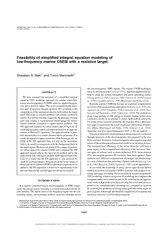Feasibility of simplified integral equation modeling of low-frequency marine CSEM with a resistive target
Peer reviewed, Journal article
Published version
Permanent lenke
https://hdl.handle.net/1956/4464Utgivelsesdato
2009Metadata
Vis full innførselSamlinger
Originalversjon
https://doi.org/10.1190/1.3192910Sammendrag
We have assessed the accuracy of a simplified integral equation (SIE) modeling approach for marine controlledsource electromagnetics (CSEM) with low applied frequencies and a resistive target. The most computationally intensive part of rigorous integral equation (IE) modeling is the computation of the anomalous electric field within the target itself. This leads to amatrix problem with a dense coefficient matrix. It is well known that, in general, the presence of many grid cells creates a computational disadvantage for densematrix methods compared to sparse-matrix methods. The SIE approach replaces the dense-matrix part of rigorous IE modeling by sparse-matrix calculations based on an approximation of Maxwell’s equations. The approximation is justified theoretically if a certain dimensionless parameter β is small. As opposed to approximations of the Born type, the validity of the SIE approach does not rely on the anomalous field to be small in comparison with the background field in the target region. We have calculated β for a range of parameter values typical for marine CSEM, and compared the SIE approach numerically to the rigorous IE method and to the quasi-linear (QL) and quasi-analytic (QA) approximate solutions. It is found that the SIE approach is very accurate for small β, corresponding to frequencies in the lower range of those typical for marine CSEM for petroleum exploration. In addition, the SIE approach is found to be significantly more accurate than the QL and QA approximations for small β.
Utgiver
Society of Exploration GeophysicistsOpphavsrett
Society of Exploration GeophysicistsCopyright 2009 Society of Exploration Geophysicists. All rights reserved. Reproduced with permission.
